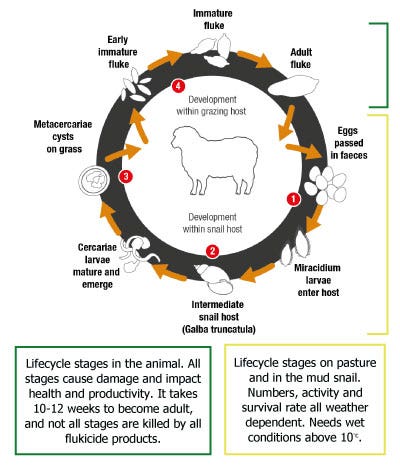
Liver fluke: what’s the problem?
Livestock farms in the wetter parts of the country will be aware of the damage liver fluke can cause. However, even where the impact on sheep flocks is visible (ie deaths from acute fluke disease), the impact on productivity for both beef and dairy herds, and the impact of subclinical disease in the sheep flock, is often under-estimated.
For example, beef animals with 10 or fewer fluke in the liver will take on average 31 days longer to finish.1 However, maintaining a high level of liver fluke control is not straightforward.
The seasonal lifecycle, the requirement for the intermediate host, the mud snail, and total dependence on weather conditions of both the mud snails and the environmental stages of the fluke, make the timing and level of fluke challenge extremely variable year to year and farm to farm. Additionally, the fact not all liver fluke products will kill all the stages of fluke in the animal, means routine treatments according to calendar dates will often miss the target, either treating too early before there are any fluke present, treating too late so the damage is already done, or simply using a product that does not kill the stages of fluke present at the time of treatment.


For more information go to www.farmanimalhealth.co.uk/sheep/sheep-liver- fluke or watch “Fight the fluke”
(www.moredun.org.uk/foundation/outreach/animation-series).
As the threat from liver fluke is farm-specific, with neighbouring farms often having very different challenges and disease levels, what questions should every farm be asking to make sure their fluke control is on target?
I know the sheep suffer from liver fluke, but I have not seen any sign of disease in the cattle. Do I need to include the cattle in any liver fluke control plans?
Yes. Liver fluke will infect both cattle and sheep (and any other mammal that ingests the infectious metacercaria [cyst] stage on vegetation), so the liver fluke control plan needs to include all grazing animals on the farm.
How do I know which animals to treat and when to treat them?
There is no easy answer. As every farm is different, and each farm will differ from year to year, testing some sentinel animals will let you know when the infectious stages start to appear on pasture (this can be any time from late summer to early winter) Also, thinking about where the animals have been grazing – are there any mud snail habitats? – will help decide if any group is at risk or not (no mud snails = no fluke risk).
I know when the fluke challenge has started, and which grazing groups are most at risk, how do I know if/when further treatments are needed?
As the season progresses, checking dung samples for evidence of liver fluke infection (coproantigen test), will let you know when re-infection happens. On high-risk pastures in high challenge years, the infection pressure will mean significant liver damage happens between treatments. Moving animals off this ground is then the only option to avoid disease. For more information watch “Liver fluke Test don’t Guess” webinar on demand at www.farmanimalhealth.co.uk/webinars.
Not all products will kill all stages of fluke in the animal, so what should I use and when?
First, always ask the prescriber or check the pack to see which active is in the product. When the fluke challenge starts, use a product that will kill the early immature fluke. Later in the season, when fewer new infections are expected, switch to a product targeting late immature and adult stages. Then in the late spring/early summer (or turn out time for cattle) switch again to a product that targets adult fluke to remove any fluke that have been missed by previous treatments.
Use medicines responsibly (http://www.noah.co.uk/responsible) Advice should be sought from the prescriber prior to use. PM-UK-21-0688 © 2021 Elanco or its affiliates. Date of preparation: July 2021. References: 1. Mazeri et al 2017.









